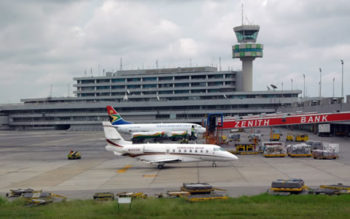
A statistics released by a research company, ForwardKeys had projected that passengers’ traffic to and from Lagos would decline by 25 per cent before the end of the year.
The company in its analysis also said that Lagos has dropped among the 10 top international airports in Africa and warned of more decline in the total number of passengers.
The breakdown of the 25 per cent according to the company indicated that in the next five months; August – December 2017, there would be 16 per cent fewer airline seats on domestic routes and 9 per cent fewer seats on international routes to and from Lagos.
The report, however, attributed the decline in airlines’ seats to the decision of the management of Arik Air to cut 53 per cent of its seats for the rest of 2017.
The company also ascribed the fall in the number of passengers to their inability to repatriate ticket funds after the currency crisis in 2016.
It said that since the currency crisis began in 2016, two major airlines, Iberia from Spain and United Airlines from the United States had ceased operations to Nigeria, while Emirates and the other foreign carriers have reduced their frequencies into the country.
Jon Howell, Managing Director of AviaDev, Africa’s leading airline route development conference added that: “The Nigerian airlines have suffered too and so this void has been filled by the ever-opportunistic Ethiopian Airlines, who began serving their fifth Nigerian destination, Kaduna on 1st August 2017 and are now the largest carrier in the Nigerian market.”
Howell observed that most of the other airports in Africa’s top 10 are seeing a healthy growth in capacity, which is more international than it is domestic, stressing that the most notable exception to this trend was Nairobi, which is seeing a 22 per cent boost in domestic capacity.
“These findings are part of a wider report on travel to Africa, produced by ForwardKeys, which predicts future travel patterns by analyzing 17 million booking transactions a day. It shows double digit growth in flight arrivals for the first half of this year and little indication that the pace of growth will slow down soon,” the report added.
The report reveals that in the first seven months of the year, 1st Jan – 31st July 2017, total international flight arrivals grew by 14 per cent over the same period in 2016.
Most significantly, growth was stronger for travel to and from the continent than within the continent. Arrivals from Europe, which make up 46 per cent of the market, were up 13.2 per cent.
From the Americas, arrivals were up 17.6 per cent; from the Middle East, they were up 14 per cent and from Asia Pacific, they were up 18.4 per cent. By comparison, intra-African air travel, which makes up 26 per cent of the market, was up 12.6 per cent.
Looking at Africa’s top 10 destination countries, there have been standout performances from Tunisia and Egypt, which are recovering from notorious terrorist attacks two years ago, up 33.5 per cent and 24.8 per cent respectively.
In addition, Morocco and Tunisia received a huge boost in arrivals from China, up 450 per cent and 250 per cent respectively, after they relaxed visa restrictions.
The one disappointment is Nigeria, which has seen a 0.8 per cent drop, in the wake of the recession in 2016, caused by a collapse in the oil price to a 13-year low.
Looking forward to the end of the calendar year, bookings for flights to Africa are currently 16.8 per cent ahead of where they were on July 31st, 2016.
Bookings from Europe are currently 17.5 per cent ahead, from the Americas 26.6 per cent ahead; from Asia Pacific 11.5 per cent ahead, from the Middle East 8.2 per cent ahead and bookings for intra-African air travel are 11 per cent ahead.